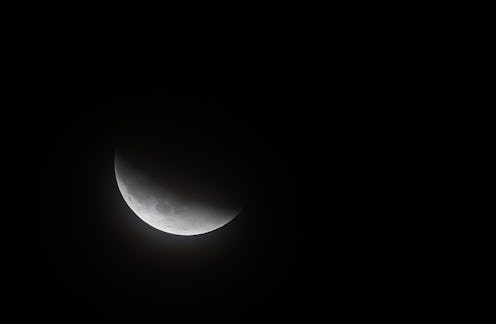Life
Here’s Exactly When You’ll Be Able To See This Month’s Total Lunar Eclipse

What's even rarer than a blue moon? A super blue blood moon total lunar eclipse. ("Once in a super blue moon eclipse" is a little clunky, though, so I wouldn't go adding it to your vocabulary.) In case you missed it, an eclipse is coming up at the end of the month, and it's definitely worth catching. So what time is January's total lunar eclipse? It all depends on your location. In North America and the Hawaiian Islands, you'll have to get up before dawn on Jan. 31. In the Middle East, Asia, Indonesia, Australia or New Zealand, you're lucky enough to get to sleep in — the eclipse won't take place until after the sun sets that day.
Before getting into the specifics, allow me to explain why there are so many modifiers attached to this eclipse. On the last day of January, the moon will be full for the second time this month, making it a blue moon. It will also be a supermoon, which means the full moon coincides with the moon's closest approach to Earth in its orbit. (Yes, technically, the moon appears a little bigger and brighter than usual, but it's hard to spot the difference without equipment.) Then there's the reason you're reading this article: On Wednesday, Jan. 31, this super-blue-moon will pass behind the Earth, through its shadow, giving us a total lunar eclipse. During an eclipse, the sunlight filters through our planet's atmosphere before reaching the moon, giving it a reddish appearance — hence the name "blood moon."
All this combines to create a super blue blood moon total eclipse. Phew.
If you're interested in catching this phenomenon, I hope you're a morning person. The Atlanta Journal-Constitution (AJC) reports that the eclipse will get started at 6:48 a.m. ET and 3:48 a.m. PT, although the Earth's shadow won't totally cover the moon for another hour. According to Time, this moment, known as totality, will take place at 7:51 a.m. ET and 4:51 a.m. PT. Overall, totality will last about an hour and 16 minutes.
Unfortunately, not all views are created equal. The AJC points out that on the eastern side of the United States, the moon will be setting as it reaches totality, so people on the West Coast will have a much better view of the eclipse than East Coasters.
Of course, this information only applies to North Americans. If you will find yourself somewhere else on the globe during the total lunar eclipse, check out the U.S. Naval Observatory's Lunar Eclipse Computer. All you have to do is select the eclipse you want to catch, enter the rough coordinates for where you'll be located, and voila! It will compute the exact times for when the eclipse begins ("penumbra") and when it reaches totality ("umbra").
You may have heard that this is the first total eclipse of a blue moon in 150 years, but that depends on your perspective. According to EarthSky, it is the first time this has happened since 1868... in the Americas. As far as the whole world goes, the last blue moon total eclipse took place on Dec. 30, 1982.
If you can't catch this particular eclipse, don't fret too much. There will be others — you just might need to travel a bit to see them. According to Time, the next total lunar eclipse can be viewed from South America, Europe, Africa, Asia and Australia on Jul. 27 later this year. But even if you're restricted to North America, you won't have to wait long: A total lunar eclipse will be visible from the U.S. on Jan. 21, 2019.
Maybe that's not quite as soon as you would like, but if there's anything to be learned from humankind's time on Earth, it's that the sky will do what it wants. See you on Jan. 31.